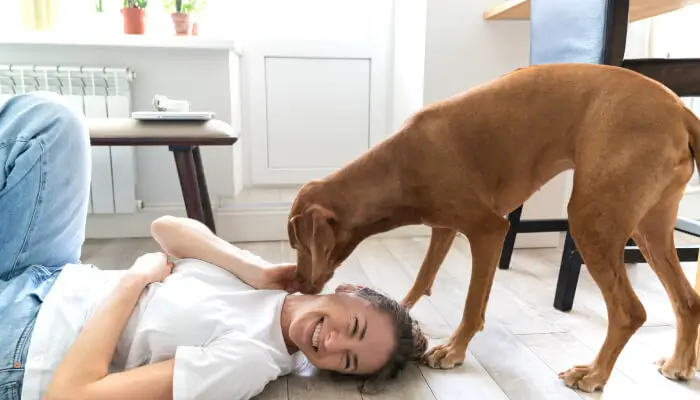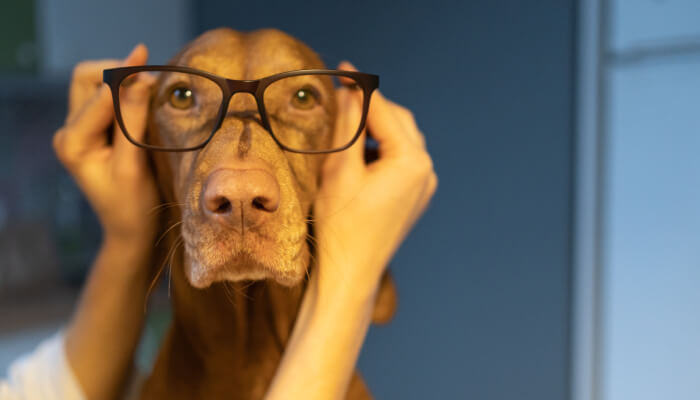One of the most common questions dog owners ask is, “How often should I clean my Vizslas ears?” Of course, the answer to this question can vary depending on several factors: frequency and type of ear infection, diet and quality of food (primarily if you feed them raw), and exercise level. But what we know for sure is that cleaning your Vizslas ears will help prevent infections from occurring in the first place.
It would help if you regularly clean your Vizsla’s ears. It would help if you did this at least once a week. But more often, if your dog spends time in dirt or water. Also, if your dog has an ear infection, it will be necessary to clean the ears every day until the infection clears up.
We hope that this blog post has helped you learn more about how frequently to clean your Vizslas’ ears, as well as some other important information related to ear care.
Is It Important To Clean My Vizslas Ears?
The ears of Vizslas are like a big sponge. This type of ear can pick up any dirt and debris if they do not receive proper care. And, if you do not clean your dog’s ears, the dirt will only get worse.
Vizslas are active dogs that like to play outside. Unfortunately, it means they are more likely to get dirt, sand, and other debris inside their ear. All these things can cause discomfort or result in infections if left untreated for a long time.
It would help if you cleaned your Vizslas ears regularly because the buildup of wax alone could lead to an infection that will be difficult to treat without proper care.
Some of the benefits of regular ear cleaning in Vizslas are lower risk of infections, reduction in symptoms related to ear inflammation and discomfort, removal of buildup wax.
How Often Should I Clean My Vizslas Ears?
The frequency with which you should clean your dog’s ears depends on how much they get dirty. For example, if your Vizslas is always playing outside and digging, the ear cleaning schedule needs to be more frequent than for a sedentary indoor pet who does not spend as much time in the dirt.
Many owners recommend checking and cleaning your dog’s ears daily for the first week after bringing your Vizsla home. It will allow you to monitor any abnormal discharge or odor that might indicate an infection. Along with this, it makes them familiar with their ears handled by humans.
After the initial period of adjusting to life with a new owner has passed, most dogs can go two to three weeks between cleanings. Once a week is usually sufficient for most dogs with healthy ears that do not get too dirty quickly. If your dog wet their ear frequently, then you will need to clean them more often.
Factors That Influence The Frequency Of Ear Cleaning In Vizsla
It would help if you cleaned your Vizsla’s ears once per week or after every other time that you bathe your dog. The frequency with which you clean your dog’s ears depends on several factors, including:
Activity Level:
The more active your dog is, the dirtier his ears are likely to be. For example, it means that a Vizsla who often spends time in heavy cover or swimming will have much dirtier ears than one whose activity level is lower.
Health Status Of Ear:
In case of an infection in the ear, you must clean them more frequently.
Type Of Ears:
The type of ears your dog also affects the frequency of ear cleaning. Dogs with floppy ears are especially susceptible to a buildup of dirt and debris in their ear canals. These dogs need to have their ears checked regularly and cleaned more frequently.
Anatomy Of Ears:
The ear anatomy of your dog also influences the frequency of ear checkups and cleaning. For example, dogs like Labs, Retrievers, Pointers, Setters, etc., whose ears hang down over their eyes are especially vulnerable to wax buildup in their ear canals. Therefore, these dogs need more frequent ear cleaning and checkups than dogs with upright ears.
Personal Preference:
Many people like to clean their dog’s ears about once per week or after every other time that they bathe the dog. It is mainly for personal reasons such as wanting a cleaner ear canal, pet comfort, etc., rather than medical ones. However, it is essential not to overdo it and clean the ear too much.
To keep their furry friends happy and healthy, owners should schedule regular veterinary visits for their dogs at least every other month, if not more frequently.
How To Clean The Ears Of Vizslas?
Vizslas are a prevalent dog breed that is very gentle. Because of this, they make excellent family dogs and companions. However, cleaning their ears can be a delicate process. So it’s important to know what you should do before attempting it on your own or taking them in for professional cleaning.
The efficient steps for cleaning the ears of Vizsla are:
Step One: Make Your Vizsla Comfortable
If your dog is tense or nervous, cleaning their ears can be a very uncomfortable experience for them. For this reason, it’s essential to start by ensuring they are calm and relaxed before beginning the process of ear cleaning.
Step Two: Cleaning The Outside Of Their Ears
The first step in ear cleaning should be to clean the outer area of their ears. It is best to clean this area with a cotton ball and hydrogen peroxide or warm water. Use the cotton ball to gently wipe away any dirt, debris, or other substances that may have gathered in or around your dog’s ear canal.
Be careful not to press too hard as you don’t want to cause them discomfort. Instead, clean one ear at a time. Also, avoid going too deep as this can be uncomfortable for your dog and potentially expose Vizlas eardrums.
Step Three: Cleaning Their Ears From The Inside
After cleaning the outside of Vizsla’s ears, clean the inside. Sweeping from the outside will only eliminate a portion of debris and earwax that can accumulate in your dog’s ear canal. So you need to clean it from the inside as well for complete cleaning.
To do this, purchase an enzymatic cleaner such as Epi-Otic from your local pet supply store. This cleaner is mainly for cleaning deep within a dog’s ear canal. It will get rid of the wax, debris, and any other substances.
Cleaning the inner eat allows for cleaning further than the outside area. So be sure to use this product for the best results.
Step Four: Cleaning Their Ears One Last Time
After spending a few minutes cleaning from the inside of your dog’s ears, it is now time to clean them one more time for good measure. Cleaning their ears at this part in the process ensures that you have removed all remaining wax and debris. So they don’t accumulate over time and potentially cause your dog distress.
To clean their ears one last time, use an alcohol-free cleanser with aloe vera or witch hazel to sanitize and disinfect their ears for the final time. Cleaning their ears one more time ensures the removal of any remaining bacteria, wax, or dirt.
Some Tips For Cleaning The Ears Of Vizslas
Some of the tips for cleaning your Vizsla’s ears include:
- Cleaning the ear with a cotton swab is not good, as it can cause damage to the interior of the ear. Instead, it is best to use gauze or moistened wipes for cleaning inside and around your pet’s outer ears.
- When you are using an over-the-counter ear cleaning solution, such as Clean Ear or Nolvasan Otic Solution, follow the instructions on the package carefully to avoid damaging your pet’s ears.
- Cleaning a Vizsla’s ears using hydrogen peroxide is not a bad idea. However, it can damage tissue and hinder blood flow inside the ear canal. In addition, it could cause irritation and inflammation. However, if you use it once a week to clean the Vizsla’s ears, this could be beneficial as it would keep them looking fresh and healthy for years to come.
- Do not clean your Vizslas ears with soap or shampoo. It can damage tissue inside of the ear canal and reduce resistance to infection. Cleaning your dog’s ears with a solution that has alcohol can cause damage to the skin. It also reduces disease resistance.
Conclusion
In conclusion, it is essential to keep your dog’s ears clean and dry. Cleaning them too often can irritate their skin. But waiting until the dirt has built up will only make it harder for you to get all of it out. The best time would be after a bath or swimming session as water tends to soften everything up and make cleaning easier.



